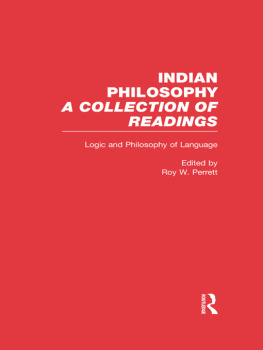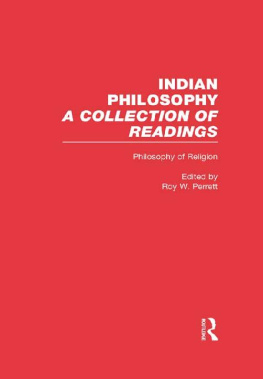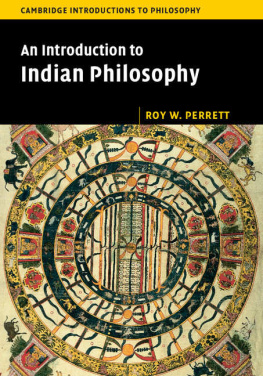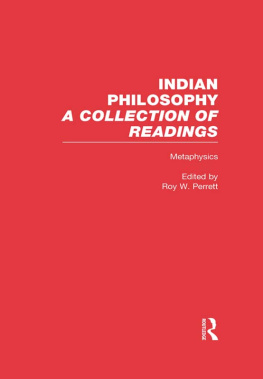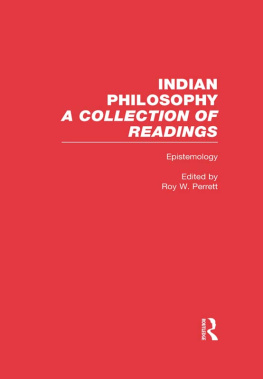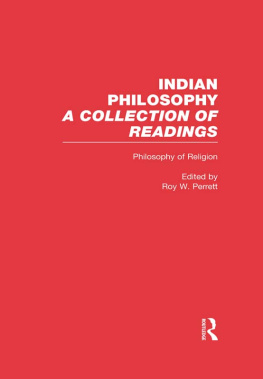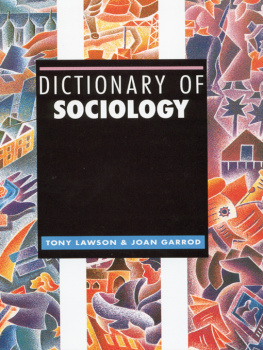Roy W. Perrett - Logic and Language
Here you can read online Roy W. Perrett - Logic and Language full text of the book (entire story) in english for free. Download pdf and epub, get meaning, cover and reviews about this ebook. year: 2013, publisher: Routledge, genre: Science. Description of the work, (preface) as well as reviews are available. Best literature library LitArk.com created for fans of good reading and offers a wide selection of genres:
Romance novel
Science fiction
Adventure
Detective
Science
History
Home and family
Prose
Art
Politics
Computer
Non-fiction
Religion
Business
Children
Humor
Choose a favorite category and find really read worthwhile books. Enjoy immersion in the world of imagination, feel the emotions of the characters or learn something new for yourself, make an fascinating discovery.
- Book:Logic and Language
- Author:
- Publisher:Routledge
- Genre:
- Year:2013
- Rating:5 / 5
- Favourites:Add to favourites
- Your mark:
- 100
- 1
- 2
- 3
- 4
- 5
Logic and Language: summary, description and annotation
We offer to read an annotation, description, summary or preface (depends on what the author of the book "Logic and Language" wrote himself). If you haven't found the necessary information about the book — write in the comments, we will try to find it.
Logic and Language — read online for free the complete book (whole text) full work
Below is the text of the book, divided by pages. System saving the place of the last page read, allows you to conveniently read the book "Logic and Language" online for free, without having to search again every time where you left off. Put a bookmark, and you can go to the page where you finished reading at any time.
Font size:
Interval:
Bookmark:

Hamblin, C.L. The Indian Tradition. In Fallacies (London: Methuen and Co., Ltd., 1970): 177189. Reprinted with the permission of Routledge, Division of Taylor and Francis.
Randle, H.N. A Note on the Indian Syllogism. Mind (1924): 398414. Reprinted with the permission of the Oxford University Press.
Staal, J.F. The Concept of Paka in Indian Logic. Journal of Indian Philosophy (1972): 156166. Reprinted with the permission of Kluwer Academic Publishers.
Staal, J.F. Negation and the Law of Contradiction in Indian Thought: A Comparative Study. Bulletin of the School of Oriental and African Studies (1962): 5271. Reprinted with the permission of the School of Oriental and African Studies.
Gillon, Brendan S., and Martha Lile Love. Indian Logic Revisited: Nyyapravea Reviewed. Jourrnal of Indian Philosophy (1980): 349384. Reprinted with the permission of Kluwer Academic Publishers.
Bhattacharyya, Sibajiban. Some Features of the Technical Language of Navya-Nyya. Philosophy East and West (1990): 129149. Reprinted with the permission of the University of Hawaii Press.
Shaw, J.L. The Nyya on Double Negation. Notre Dame Journal of Formal Logic (1988): 139154. Reprinted with the permission of the University of Notre Dame.
Bhattacharya, Sibajiban. The Middle Term. Notre Dame Journal of Formal Logic (1968): 229232. Reprinted with the permission of the University of Notre Dame.
Mohanty, J.N. Psychologism in Indian Logical Theory. In Bimal Krishna Matilal and Jaysankar Lal Shaw editors., Analytical Philosophy in Comparative Perspective (Dordrecht: Reidel Publishing Company, 1985): 203211. Reprinted with the permission of Reidel Publishing Company.
Davis, Lawrence. Tarka in the Nyya Theory of Inference. Journal of Indian Philosophy (1981): 105120. Reprinted with the permission of Kluwer Academic Publishers.
Matilal, B.K. Anenknta: Both Yes and No? Journal of the Indian Council of Philosophical Research (1991): 112. Reprinted with the permission of the Indian Council of Philosophical Research.
Staal, J.F. Sanskrit Philosophy of Language. In Thomas A. Sebeok, editor, Current Trends in Linguistics : Vol. , Linguistics in South Asia (The Hague: Mouton, 1969): 499531.
Brough, John. Some Indian Theories of Meaning. Transactions of the Philological Society (1953): 161176. Reprinted with the permission of Blackwell Publishers Ltd.
Matilal, Bimal Krishna. Reference and Existence in Nyya and Buddhist Logic. Journal of Indian Philosophy (1970): 83110. Reprinted with the permission of Kluwer Academic Publishers.
Matilal, B.K., and P.K. Sen The Context Principle and Some Indian Controversies Over Meaning. Mind (1988): 7397. Reprinted with the permission of the Oxford University Press.
Siderits, Mark. The Sense-Reference Distinction in Indian Philosophy of Language. Synthese (1986): 81106. Reprinted with the permission of Kluwer Academic Publishers.
Herzberger, Hans G., and Radhika Herzberger. Bhartharis Paradox. Journal of Indian Philosophy (1981): 332. Reprinted with the permission of Kluwer Academic Publishers.
Despite large and obvious differences, the history of Indian Logic runs curiously parallel with that of the Logic of Europe, at least in its classical and medieval periods; so much so that one is tempted to see the two as advancing side by side, rather than separately. So far as the classical period is concerned we may, in fact, have tended to underestimate the extent of the contact between India and Greece; for though no one now maintains, as some historians have argued, that Indian Logic was directly inspired by Aristotle, or even that influences in either direction can be definitely traced, it is known that there was considerable commerce between the two regions. Aristotles most famous pupil Alexander had, after all, penetrated to India in the course of his military ventures, though it is doubtful that he found time to lecture the inhabitants on Logic. There were subsequently Greek settlements on the north-west frontier, and it would be surprising if there were not some interpenetration of ideas. Later, with the rise of Mohammedanism, these ties were broken, and India and Europe were held apart by a civilization largely hostile to both. The Arabs, it is true, helped to preserve the European tradition to some extent by taking over Aristotles works in translation; but they did not themselves discover the Indian Logic and, in fact, the Moslem invasion of India nearly caused its extinction. Many of our modern Sanskrit texts are re-translations from versions that survived in Tibet. We can also study such doctrines as went with Buddhism to China.
The actual authors of the earliest Indian treatises are dim,
Before considering what Gautama and Vtsyyana say about Fallacies it is necessary to sketch their theory of inference. This betrays a dialectical origin almost as strongly as Aristotles Topics . A single pattern of inference is given, without moods or figures. An inference has five members. Illustrated by the stock example of later writers, they are:
(1) (Thesis): The hill is fiery.
(2) (Reason): Because it has smoke.
(3) (Example): Whatever is smoky is fiery, like a kitchen.
(4) (Application): And this hill is smoky.
(5) (Conclusion): Therefore it is fiery.
Since Gautama calls (3) just Example, it seems likely that, in the illustration, the statement of a general rule, Whatever is smoky is fiery, is a later importation: the original idea is simply that an example of the operation of the (unstated) connection between the major term fire and middle term smoke should be given. If this seems strange, comparison with Aristotle Rhetoric (1393a 221394a 18) might be helpful. In general the aim of this theory of inference is much closer to Aristotles aim in his Rhetoric than it is to what we are used to and which derives from the Prior Analytics. Gautama defines an example as a case in which the
The apparently useless repetitive character of (4) and (5) led to their being dropped by some later writers. Their presence is less surprising, however, if the whole inference scheme is seen as a pro forma for the setting-out of inferences in practice, with an aim of securing comprehension in an audience or persuasion of an opponent. Here it is interesting that we are told by Vtsyyana in his commentary that others raised the number of members of the syllogism to ten, by adding the desire to know, doubt, belief in possibility of solution, purpose in view in attaining the conclusion and removal of doubt. If these are interleaved with the other five we have the pattern of a veritable dialogue, in which the added members represent the reactions or contributions of a second participant. We could dramatize the situation something as follows:
| A | The hill is fiery. ( Thesis ) |
| B | Why ? ( Desire to know ) |
| A | Because it is smoky. ( Reason ) |
| B | Does that follow ? ( Doubt ) |
| A | As in the case of a kitchen. ( Example ) |
| B | Oh, I begin to see! ( Belief in possibility of a solution ) |
| A | And, you see, this hill is smoky. ( Application ) |
| B | Now we are getting somewhere. ( Purpose in view in attaining the conclusion ) |
| A | So the hill is fiery. ( Conclusion ) |
| B | Of course! ( Removal of doubt). |
The scheme is artificial at some points, as witness the vapidity of the remarks I have had to write in for the second speaker. However, there can now be little doubt that Gautamas scheme is aimed at representing the presentation of an argument to others ; that is, at Rhetoric or Dialectic, not pure Logic.
Font size:
Interval:
Bookmark:
Similar books «Logic and Language»
Look at similar books to Logic and Language. We have selected literature similar in name and meaning in the hope of providing readers with more options to find new, interesting, not yet read works.
Discussion, reviews of the book Logic and Language and just readers' own opinions. Leave your comments, write what you think about the work, its meaning or the main characters. Specify what exactly you liked and what you didn't like, and why you think so.

